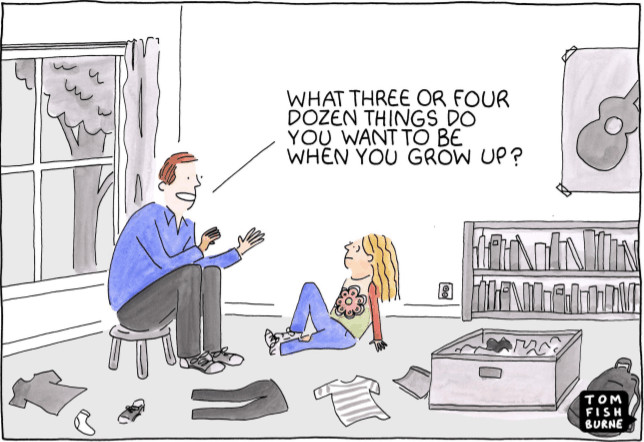Careers in the 2020s: What every business leader needs to know
Navigating the shift to portfolios of lifelong reinvention

We’ve never experienced as many workplace changes simultaneously as we are right now. Hybrid models are the new norm, workers have gained the upper hand in the employee-employer relationship, and many of us are rethinking what we want to do and the steps we’ll need to take to get there. Perhaps most notably, the Great Reassessment has created a clear call to action: Employees are no longer settling for dead-end jobs but instead searching for meaningful professional pathways.
There’s no doubt that careers in the 2020s are different. Change comes with many exciting opportunities, but it also means that leaders will need to recalibrate their strategies and embrace new ways of thinking. While there’s still some uncertainty surrounding careers of the current decade, our own Jeff Schwartz is shining a light on the important first steps executives will need to take to set their businesses up for success.
He’s also pulling some leading HR voices into the discussion, including Lucrecia Borgonovo, Chief Talent and Organizational Effectiveness Officer at Mastercard; Jean Pelletier, VP of Digital Talent Transformation at Schneider Electric; Judith Konermann, Global Head of Strategic Workforce Planning at Philip Morris International; and Jennifer Pierce, VP, Talent Management and DE&I at Walmart.
4 lessons leaders must learn to upgrade career development strategies
With new ways of working comes a new approach to professional development. As organizations strive to keep up with today’s accelerated pace of change, here are a few lessons executives should keep in mind to successfully navigate careers in the 2020s.
#1. The next balancing act is about flexibility and connectivity
The days of strict 9-5 work schedules have come to a close. Employees are looking for more autonomy, and they’re expecting some decision-making power—both in where and when they’re working.
Transitioning away from cultures that prioritize in-person connections above all else may be a bold move for some organizations, but it’s likely to pay off. Gartner found that 43% of respondents believe that flexibility in working hours has enabled them to achieve greater productivity. However, while workers might want their employer to take a step back on the scheduling front, that doesn’t mean they’re content with being out of the loop entirely.
In fact, as workforces continue to disperse, leaders are going to need to go the extra mile to ensure people feel connected to their colleagues and the work they’re doing. Visibility into opportunities to learn new skills and progress careers will be crucial to fueling successful professional development during the decade of disruption.
Pelletier describes the importance of nailing this balancing act, noting, “We’re hearing a lot about flexibility, but people also want to stay connected. They want a connection between work and life, and at the same time they’re expecting a new level of transparency that goes beyond just jobs.”
#2. Upskilling is part of every professional journey
The world is moving fast, and careers have to keep up. In recent years, many businesses have begun moving into adjacent industries and reinventing themselves to stay competitive.
As priorities change, the roles designed to support them will inevitably evolve as well. Most employees will need to learn new things, as the World Economic Forum predicts that by 2025, upskilling will be required for half of the globe’s workforce. Pierce pinpoints this as a priority, noting, “We know that careers like cashiers are going to be impacted by technology, so we’re thinking about ‘how can we bring those skills inside the organization and upskill you to a new role so that we can prepare you to be ready for the future?’”.
It’s going to fall on leadership to ensure their people are prepared for the fast-moving future of work. Konermann explains the key to keeping pace is making sure employees have the insights needed to engage in meaningful conversations about their professional journeys. “How can we make sure we give people knowledge and insights so they can talk to their line managers about their next steps? And how can we support them in the best possible way?”
Leaders are going to need to be able to answer those questions to ensure their workforce is prepared for their company’s next chapter.
#3. New generations usher in new mindsets
It’s impossible to talk about careers of the 2020s without mentioning some of the groups of people that will shape them most: millennials and Generation Z. By 2030, workers born between the mid-1990s and 2010 will make up one-third of the workforce. So what kinds of changes should businesses make to prepare for this influx of new talent?
Instead of focusing solely on generational differences, Pierce reminds us that we’re all looking for the same things from our employers. “Ultimately, we’re all searching for purpose, mastery, and autonomy. We’re all searching for a life well-lived,” she explains.
What sets the newest generation of employees apart is not their aspirations and expectations, but rather their mindsets as they enter the workforce. “If I think about the younger generation today, they’re not standing for this idea that work and life are separate entities,” Pierce explains. “For them, it is their whole life. As they begin their career journeys, I notice they’re starting with more clarity about what they won’t tolerate, so I think there’s a different mental model coming in.”
Since Gen Z employees are entering the workforce with a desire to learn and grow, business leaders will need to ensure new development opportunities are always within reach. “There’s what I like to call ‘the semester system impact’”, Pierce notes. “Every four months you finish a course, so in the work world, now every four months you want a new job.” While traditional work models might not be set up that way, projects and gigs can offer an enticing alternative. With a talent marketplace, employees can seek out ad-hoc projects and part-time opportunities that enable them to expand their horizons while staying within your organization.

#4. Skills dictate compensation decisions
Borgonovo points out another career topic that has been getting a lot of attention: salary shifts. She explains, “There has been a lot of conversation about how compensation is going to change. In the past, we’ve had these hierarchical models, where people felt valued if they continued to move up in the organization.”
But now that careers are no longer ladders, but instead webs of vertical and horizontal development opportunities, Borgonovo asks, “How do we enable this sustainable lattice from a compensation perspective?”
Since business priorities are evolving rapidly and the need for upskilling is reaching a peak, organizations will put a premium on in-demand skills. As Konermann puts it, “Skills are the new currency. The new question is how do we deal with that in the organization and how will we pay people accordingly?”
While it may be too early to arrive at a definitive answer, Schwartz and our panel of HR leaders have a few pieces of advice to offer. First and foremost, it’s a challenge that will require insights from across the organization. As Schwartz explains, “Careers are a wicked problem. For wicked problems, we need a diverse group of leaders and professionals working on it. It’s not just an HR problem, it’s something everyone needs to work on.”
It’s also a change that promises to transform the nature of HR as a profession. In a world where skills are the new currency, we’re going to need leaders to oversee the exchange of talent and manage the supply and demand of capabilities. “If skills are the new currency, I think markets are the new pricing mechanism,” Schwartz says. “Markets are the mechanism by which we are orchestrating the relationship between employees and the parts of our organizations that need labor and teams and technology to actually get work done. We’re trying to figure out how to become true market makers, not order takers,” he concludes.
Right now, we’re all weighing the pros and cons of major decisions that are going to shape how our organizations function in the new world of work. Ultimately, sticking with the status quo is likely the most dangerous choice. As Schwartz reminds us, the question we all need to walk away with is, “Are we doing enough things differently to move forward in the age of disruption?”
To learn more about what it takes to upgrade learning and development opportunities, check out our report on workforce skills.





